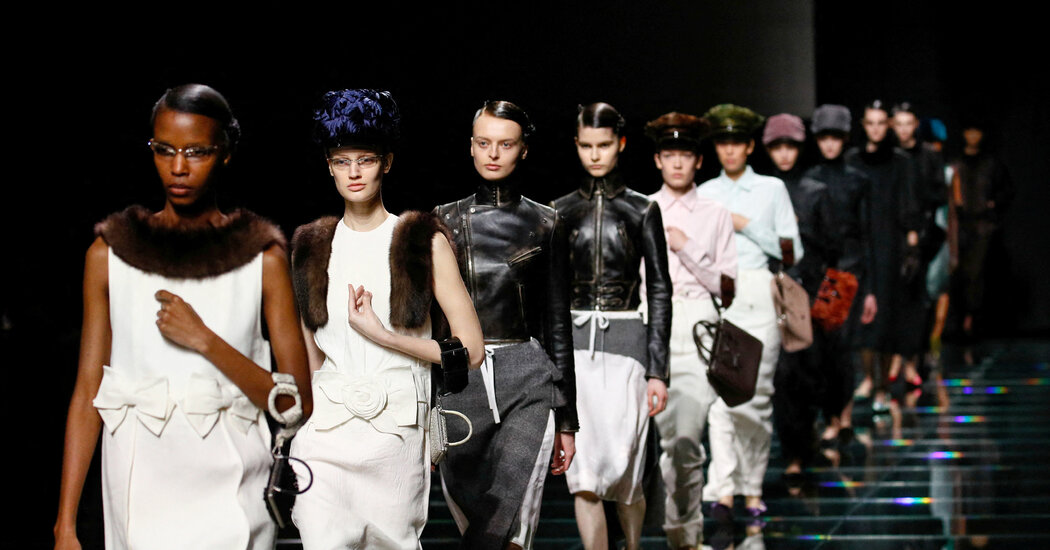Miuccia Prada, currently American Vogue’s pioneering septuagenarian cover girl, was standing backstage after the Prada show, bedecked in emeralds and jade and looking slightly terrified as Emma Watson and hordes of well-wishers and journalists swarmed around her like locusts. Such is life when you transcend the role of designer and become more like a divining rod that indicates which way the cultural water is flowing. And that is?
Toward “history,” she said as her co-creative director, Raf Simons, sipped Prosecco beside her. Or to be specific, toward the way history teaches us about where we are going. As Mr. Simons said in a news release later, “You can only realize your future if you know your past.”
It’s not a blinding insight — if we don’t learn from our actions, we are doomed to repeat them, and so on — but at this particular time, when it often feels like we actually are repeating them and memories are awfully short, it’s worth a reminder (as Mrs. Prada said backstage). Besides, fashion can bring the point to life as well as any lecture. Maybe better.
History has been much in the air in Milan. Maybe it’s because it was two years ago this week that Russia invaded Ukraine, or because the American presidential election feels like it’s dangerously on rewind. Maybe it’s because history-based films like “The Zone of Interest” and “Killers of the Flower Moon” and “Oppenheimer” are sweeping the awards season, which parallels the ready-to-wear season. Or maybe it’s as simple as the fact that history is a living thing in fashion, given how many European houses are concerned with preserving their own heritages, constantly looking backward to define their identities. Probably all of the above.
The issue was front and center at the Moschino show, where Adrian Appiolaza was making his debut as creative director of the brand that Franco Moschino built on a base of style and pointed cultural activism masquerading as a bit of fun. Jeremy Scott reinvented it as high camp, and Mr. Appiolaza is now charged with taking it forward.
The first thing he had done, the designer said backstage before the show, was “go to the archive. My idea was to really dig into Franco’s world. I was overwhelmed with all the pieces that they have.” Then, he said, he picked certain notable points to revisit.
The result was a whistle-stop tour through Moschino iconography in 41 looks. The cowboy? He was there, in the form of truncated wrangler hats with baseball cap backs and long, cancan skirts over faded denim. The pointed slogans? They were there, too: see one long knit dress with “Peace” cascading down the center, or an oversize T-shirt telegraphing “Love.” There were smiley face knits, pearls, question mark and polka dot suits and surreal cloud prints; even a paper bag handbag stuffed with groceries.
The clothes were more relaxed and easier to wear than the exaggerated looks that distinguished Mr. Scott’s tenure; so was the jokery, which was less geared toward social media memes than lightening up the weight of the everyday. What was missing, however, was any sense of Mr. Appiolaza, and how he might want to make the brand his own.
He only arrived at Moschino in January, so to be fair, he hasn’t had much time. Perhaps — hopefully — that will change with his next collections. Otherwise, all that’s left is a very professional, somewhat pallid, exercise in nostalgia.
A place where it is easy to get stuck. Nostalgia, after all, implies a certain passivity — things were better back then! — which is risky messaging for brands selling the future. Which is perhaps why Mrs. Prada and Mr. Simons were at such pains to avoid it.
Instead they were mining their grab bag of fashions past for female totems — bows above all (and not the TikTok kind; the kind that could school the TikTok crowd), but also fur trim and silk bloomers, aprons and linen handkerchiefs and lingerie, land girl suiting, 1950s va va voom sheaths and ’60s shifts — and then actively messing with them, chopping it all into pieces and collaging the fragments back together to force reconsideration. Not with frustration, but with affection.
Sleeveless shells flew little bows like fringe down the front and were layered over silk bloomers. Some skirts had bigger bows, like bustles at the back; other heavy tweeds turned out to be false fronts that revealed silk slips at the rear. Midcentury cocktail dresses were reimagined in technical nylon with the sort of multi-utility pockets normally seen on the ski slopes. Ditto one fantastic trapeze coat.
Top-handle bags weren’t tucked into the crook of the arm, they were looped on by dint of a mini belt. A bag belt? Everything seemed to be worn with a jewel-tone velvet cap, which called to mind the sort of headgear associated with beat cops, French Legionnaires and Civil War soldiers, depending on your reference points (in any case: the police of the moment).
It was a little schizophrenic and often kind of awkward, but also compelling, the uniforms of a madcap historian pouring martinis at a cocktail party and riffing on Mary Wollstonecraft, Simone de Beauvoir and how we got to here.
Backstage, Mrs. Prada was quoting a philosopher whose name she could not remember, but whose words she paraphrased as, “Taking away a piece of the past is separating it from its cage.” She and Mr. Simons may not know where we go next (that would be demanding too much), but at least they are offering the tools to think about it in style.







